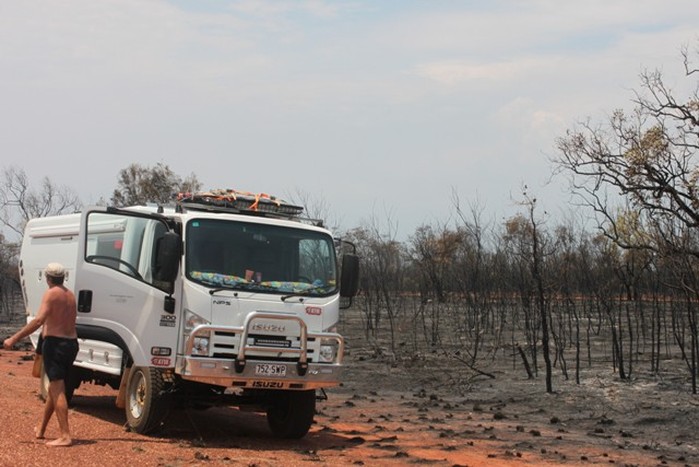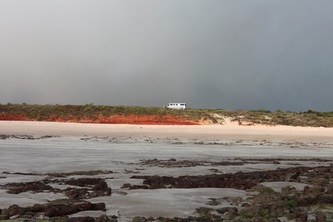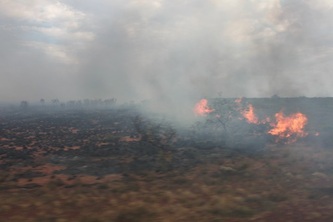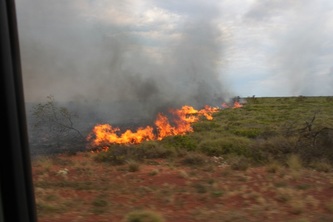
We have been caught up in a couple of bushfires in the north-west and have been fascinated by burning difference between can-do people up here and flaming daftness of dwellers in the south.
A black smoke sky added to the colour contrasts of Cape Leveque, a fire burnt across and closed the Great Northern Highway trapping us at Port Smith on Eighty Mile Beach and we dodged past a few others on the way south. Up in the north, however, they have a better acceptance of the inevitably of bushfires and the need to cool burn to keep the kindling down. And of course, in the north-west, the scrubby flora is not as deadly as the tall gums in the south.
We almost choked not on smoke but on the bizarre claim by Green MP Adam Bandt, one of the most curious characters elected to the lower house. First he said Tony Abbot was to blame for the fires; later he tried to backpedal a little but was still insisting that fuel reduction was not the answer.
“If you want to reduce the amount of fuel that’s available to burn, the best thing we can do is work to get global warming under control,” he told ABC Radio. Huh? Getting global warming “under control” when human pollution is reckoned to be a factor in, not the sole cause of, our changing weather is blinkered and bizarre. Even if we could, how would that cause the lethal fuel build-ups in rural Australia to mysteriously disappear?
The Ludwig Leichardt diaries published by the Queensland Museum shine light on the endemic need for cool bushfires to rejuvenate the bush.
We have travelled a bit in the footsteps of old Ludwig. His writings about the Australian bush barely touched by Europeans are fascinating in their observations. He immersed himself in Aboriginal culture for up to nine months at a time and recorded their uncanny affinity with nature.
The Australian Review on October 19 reported: “He could see that burning brought growth, luxuriance, a profusion of animals. Burning was all around him…..
“At the time Leichardt was writing these words, the modern Australian system of land use was just being imposed and the fire-sensitive growth cycle of native plants and trees suppressed. ‘I longed,’ writes Leichardt, ‘to move those stupid enemies of fire onto such a plot of young grass to hear lectures alternatively from horses, sheep, oxen and kangaroos about the advantages of burning the old grass.’”
We don’t know if poor Ludwig is turning in his grave now because we don’t know where his bones lie. We do know he would shudder to see what is being done today by people who claim to have an affinity with the bush and a desire to preserve it.
Tony and I have driven through rural residential areas in southern states and seen lovely homes in which we would never sleep a wink. They are perched on ridges, hidden among tall trees and in the breeze path of gullies filled with highly combustible undergrowth. Green-influenced councils and state governments have put deadly limits on clearing and cool burning: in the Blue Mountains one council has a 2m limit for a firebreak around a property. That’s like keeping Guernsey bulls out of your garden with a guipure lace fence.
We can’t blame global warming, firebugs, the odd army mishap, carelessness, escaped fires or lightning strikes for the ferocity and destructiveness. Hot days and bushfires are inevitable. We can blame lack of prescribed burning and the deadly locations of increasing numbers of houses for the intensity of the blazes and the scale of destruction.
I’m with Ludwig and Abbott in their responses to those who talk through their hats. Maybe we should cull the bush of all the silly buggers and put them back in the cities where they belong. And maybe we should get insurance companies to put high premiums on fire-risk locations and/or council areas run by dippy greenies who think they save the land by prohibiting clearing and preventative burning.
Why should our insurance premiums go up to pay to replace homes of those who keep blindly ignoring today’s evidence and observations of explorers 200 years ago?
A black smoke sky added to the colour contrasts of Cape Leveque, a fire burnt across and closed the Great Northern Highway trapping us at Port Smith on Eighty Mile Beach and we dodged past a few others on the way south. Up in the north, however, they have a better acceptance of the inevitably of bushfires and the need to cool burn to keep the kindling down. And of course, in the north-west, the scrubby flora is not as deadly as the tall gums in the south.
We almost choked not on smoke but on the bizarre claim by Green MP Adam Bandt, one of the most curious characters elected to the lower house. First he said Tony Abbot was to blame for the fires; later he tried to backpedal a little but was still insisting that fuel reduction was not the answer.
“If you want to reduce the amount of fuel that’s available to burn, the best thing we can do is work to get global warming under control,” he told ABC Radio. Huh? Getting global warming “under control” when human pollution is reckoned to be a factor in, not the sole cause of, our changing weather is blinkered and bizarre. Even if we could, how would that cause the lethal fuel build-ups in rural Australia to mysteriously disappear?
The Ludwig Leichardt diaries published by the Queensland Museum shine light on the endemic need for cool bushfires to rejuvenate the bush.
We have travelled a bit in the footsteps of old Ludwig. His writings about the Australian bush barely touched by Europeans are fascinating in their observations. He immersed himself in Aboriginal culture for up to nine months at a time and recorded their uncanny affinity with nature.
The Australian Review on October 19 reported: “He could see that burning brought growth, luxuriance, a profusion of animals. Burning was all around him…..
“At the time Leichardt was writing these words, the modern Australian system of land use was just being imposed and the fire-sensitive growth cycle of native plants and trees suppressed. ‘I longed,’ writes Leichardt, ‘to move those stupid enemies of fire onto such a plot of young grass to hear lectures alternatively from horses, sheep, oxen and kangaroos about the advantages of burning the old grass.’”
We don’t know if poor Ludwig is turning in his grave now because we don’t know where his bones lie. We do know he would shudder to see what is being done today by people who claim to have an affinity with the bush and a desire to preserve it.
Tony and I have driven through rural residential areas in southern states and seen lovely homes in which we would never sleep a wink. They are perched on ridges, hidden among tall trees and in the breeze path of gullies filled with highly combustible undergrowth. Green-influenced councils and state governments have put deadly limits on clearing and cool burning: in the Blue Mountains one council has a 2m limit for a firebreak around a property. That’s like keeping Guernsey bulls out of your garden with a guipure lace fence.
We can’t blame global warming, firebugs, the odd army mishap, carelessness, escaped fires or lightning strikes for the ferocity and destructiveness. Hot days and bushfires are inevitable. We can blame lack of prescribed burning and the deadly locations of increasing numbers of houses for the intensity of the blazes and the scale of destruction.
I’m with Ludwig and Abbott in their responses to those who talk through their hats. Maybe we should cull the bush of all the silly buggers and put them back in the cities where they belong. And maybe we should get insurance companies to put high premiums on fire-risk locations and/or council areas run by dippy greenies who think they save the land by prohibiting clearing and preventative burning.
Why should our insurance premiums go up to pay to replace homes of those who keep blindly ignoring today’s evidence and observations of explorers 200 years ago?







 RSS Feed
RSS Feed
